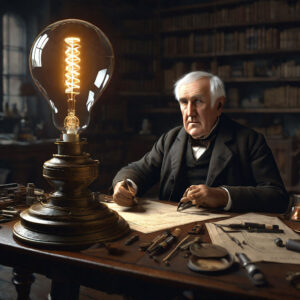
Who invented the light bulb? No, it wasn’t Thomas Edison. Light bulbs were in use long before Edison applied for the patent in 1879. British inventor Humphry Davy invented an incandescent light bulb in 1801 and created the “arc lamp” in 1809.
In 1835, Scottish inventor James Bowman Lindsay demonstrated a constant electric light in Dundee. In 1840, British scientist Warren de la Rue also demonstrated a light bulb. In 1841, British inventor Frederick DeMoleyns patented a light bulb and in 1844 American John Wellington Starr filed a U. S. patent caveat for an incandescent lamp. Many others would follow suit but none of the bulbs were effective for everyday use.
In 1872, Russian engineer Alexander Lodygin invented an incandescent light bulb for which was awarded a Russian patent in 1874. In 1877, William E. Sawyer developed a incandescent light in partnership with Albon Man. In the late 1870s, Hiram Stevens Maxim – who later, in 1884, invented the first fully automatic machine gun – developed a light bulb and in 1880 installed the first electric lights in a New York City building (the Equitable Life Building at 120 Broadway).
British inventor Joseph Wilson Swan started experimenting with light bulb designs in 1850. On December, 18 1878, he demonstrated a light bulb at a lecture in Newcastle upon Tyne that soon had the attention of the world, including Edison. Swan was awarded a light bulb patent (patent No. 4933) only in 1880, the year in which his house in Gateshead, England became the first house in the world lit by a light bulb.
Edison entered the race to develop an effective light bulb in 1878. He struggled with a solution at first but, with the assistance of Francis Upton, on October, 22 1879 he had a breakthrough. His light bulb burned continuously for 13 hours. Edison filed for a patent on November, 4 1879.
Edison continued with experiments and by the end of 1880 his light bulbs burned for up to 600 hours. Eventually they would glow for up to 1,200 hours.






